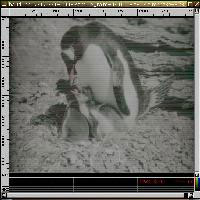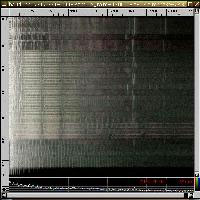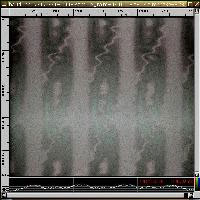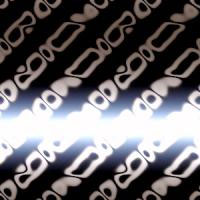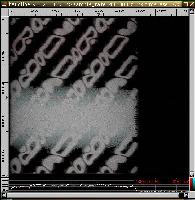Jason Downer
CopperCloudMusic
Sound Editor
Composer
Welcome to the wonderful world of Enscribe 0.1.0
Enscribe is free software, released under the General Public License. You should know that there is no warranty on this software for any reason whatsoever. If it eats your dog, you're just out of luck. That being said...
What does Enscribe do?
Enscribe creates digital audio watermark images from photographic images.
These images can only be seen using a third party frequency vs time display, such as my favorite, Baudline (http://www.baudline.com).
Images are still visible even after such audio mangling techniques as MP3/Ogg compression, reverb, chorus, etc. Heavy EQ and flange can stripe out vertical sections, but they can also ruin an otherwise good song as well.
How does it work?
You give it an image file (JPG, PNG, WBMP) and it outputs an audio file.
The scanlines of the input image are converted into frequency components and then using an inverse Fast Fourier Transform, are converted into sound. The left side of the image is the low frequency end, and the right is the high end, up to just under the Nyquist limit if you want it.
Supported audio formats include Microsoft WAV, Apple AIFF, Sun Microsystems AU, and raw output. Raw output can also be sent to stdout.
The audio images sound like high pitch buzzing or hissing.
Colors!
Because Baudline can display stereo images in two tone color (one for right, the other for left), color can be encoded into the audio file. It's not perfect, since there are only two color axes, and it is dependent upon your viewer, but it's still pretty cool. Baudline's default axes are green and purple, but I like red and cyan on my display.
Erik Olson, the author of Baudline, had an interesting idea about encoding a third color channel using phase lag between the left and right channels. Using the "-monet" switch in Baudline activates a psuedo-third color channel based on the differences in those signals. While I'm still having trouble with getting the hues right, it still looks dang cool.
Here are the relevent switches:
enscribe -color=monet
baudline -monet
Okay, what can I do with this software, you ask?
You can use software such as Ardour or Audacity to blend this audio file in with another, thereby marking the audio with secret messages or pictures of your dog.
You can put copyright information in also, but it probably wouldn't be long before someone figures out how to erase those (C) watermarks.
Compiling
Enscribe is distributed as source. To compile it, you need gcc and the following software libraries installed:
gd
gd-devel
libsndfile
All are available through http://freshmeat.net
When you're ready, type
make
And if you want it available system wide, as root type
make install
I've put a precompiled linux binary for i386 here in case you just hate to compile things. You still need to have libsnd and gd on your system though.
Usage and Options
Enscribe has quite a few options, to see them all, type "enscribe -help"
Here's a sample:
Enscribe 0.0.3 (c) 2004 Jason Downer
Homepage: http://jbd.zayda.net/enscribe/
This is ALPHA software.
Enscribe is free software, distributed under the General Public License.
There is NO warranty; not even for MERCHANTABILITY or FITNESS
FOR A PARTICULAR PURPOSE.
Usage: enscribe [switches] input_image output_audio
Valid image formats: Jpeg, Png, WBMP, Xbm, GD, GD2
Switches:
-inverse, -i Inverse (negative) input image
-color=[mode] Sets color conversion method for the input file:
g greyscale
m monochrome, ugly
rc red and cyan (default)
oa orange and aqua
yb yellow and blue
gp green and purple (for Baudline(TM) )
wb reyscale on left, inverse on right. Weird.
monet pseudo 3-color for "baudline -monet" display.
-transform-size=[size] iFFT blocksize:
-ts=[size] 0 = 512
1 = 1024 (default)
2 = 2048
3 = 4096
-lf=[start] Set low frequency start of image (default=0%)
-hf=[stop] Set high frequency stop of image (default=100%)
-hiss, -h Uses hissing rather than buzzing
-oversample, -o 4X oversample audio (activates -hiss)
-mono, -m Produce mono ouput audio file.
-stereo, -s Produce stereo ouput audio file (default).
-rate=[rate] Set audio sample rate (44100 default).
-wav Output wav audio (default)
-aiff Output aiff audio data
-au Output au audio data
-raw Output raw audio data
-stdout Output raw audio data to <stdout>
Subformats
-de File format default endian-ness (default)
-le Little Endian
-be Big Endian
-ce Your CPU's endian-ness
-pcm8 Signed 8-bit data
-pcm16 Signed 16-bit data (default)
-pcm24 Signed 24-bit data
-pcm32 Signed 32-bit data
-float 32-bit floating point
-double 64-bit floating point
-ulaw U-Law
-alaw A-Law
A typical use of this command would look like:
enscribe -oversample -lf=5 -hf=70 -color=yb -wav north.jpg output.wav
lame output.wav north.mp3
MISC
PenguinsNote that only greyscale and monochrome are supported in monoaural mode.
To reduce buzzing, I recommend always using the -hiss or -oversample switches. They do reduce image quality, but they sound better, and are more impervious to digital mangling.
MP3 and Ogg encoders are LOSSY encoders, and what they like to lose most are the upper harmonics of a file. If you are going to compress your output audio, I suggest you bring down your high frequency stop to around 65 or 70 like this
-hf=70
If you are using your file in a lossless way, feel free to place your images anywhere in the spectrum, they should survive just fine.
I hope you enjoy playing around with this software. Feel free to send me suggestions, bugs, or links to cool files you've made.
